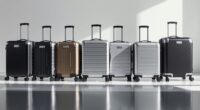To arrange your gear for easy access, prioritize your essentials and store them in the most accessible compartments. Use a zone system to assign specific areas for tech, snacks, or personal items, and keep frequently used items at the top or in front pockets. Organize small items with pouches to prevent loss and optimize space. Regularly review and adjust your layout to stay practical—if you want to master efficient backpack organization, there’s more to discover below.
Key Takeaways
- Prioritize essential items and place them in accessible compartments for quick retrieval.
- Use designated zones and color-coded labels to organize categories like electronics, snacks, and toiletries.
- Optimize weight distribution by positioning heavy items near the back and center for stability.
- Utilize small pouches and compartments to keep tiny items organized and prevent loss.
- Regularly review and adjust your layout to accommodate changing needs and enhance efficiency.
Prioritize Your Essentials

To keep your backpack organized, start by prioritizing your essentials. Focus on selecting items you genuinely need daily, avoiding unnecessary weight that can make your bag cumbersome. A lighter bag reduces strain and enhances comfort, especially if it features an ergonomic design that distributes weight evenly across your shoulders and back. When you choose your essentials, consider their size and importance, placing only what’s necessary at the top or in easily accessible areas. This strategic placement minimizes clutter and makes grabbing what you need quick and effortless. Remember, a well-organized backpack with a manageable bag weight minimizes fatigue and helps maintain good posture throughout your day. Prioritizing essentials ensures a balanced, comfortable carrying experience that keeps you prepared without overloading. Additionally, applying space and organization techniques like designated zones and multi-functional compartments can further enhance accessibility and efficiency. Incorporating optimized storage solutions can maximize your backpack’s capacity and organization.
Use Compartments and Pouches
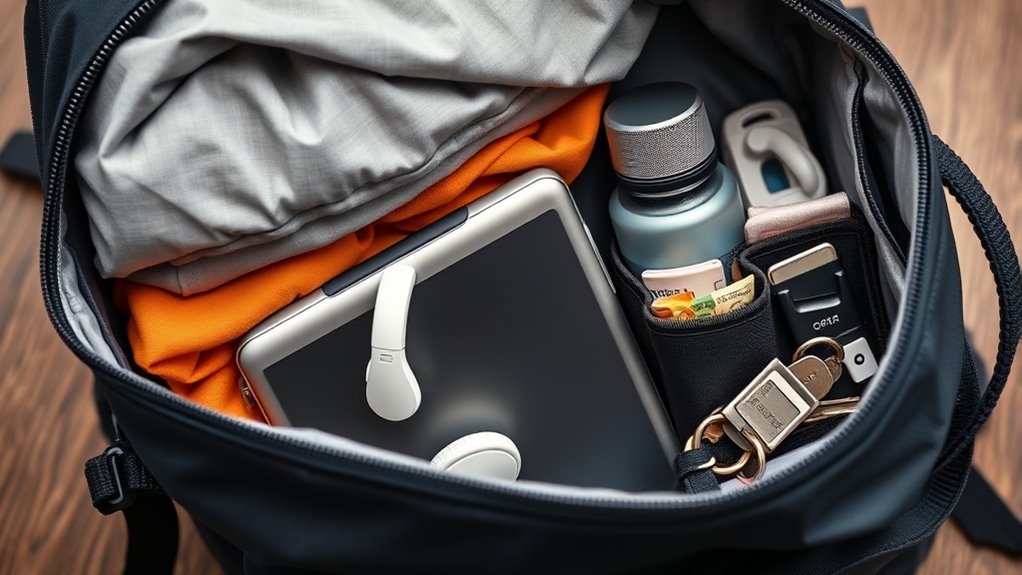
Using compartments and pouches helps you organize your backpack efficiently. You can assign designated storage zones for different items, making them easy to find. Elastic and zip pouches keep smaller essentials secure and accessible. Incorporating automation technologies can further streamline organization and improve overall efficiency. Additionally, implementing a systematic approach to arranging your gear ensures that you can quickly locate items when needed. Choosing materials that are durable and easy to clean can also extend the lifespan of your organization system. Incorporating structured layouts can help optimize space and maintain order over time, especially when combined with clear labeling techniques to enhance visibility and quick retrieval.
Designated Storage Zones
Designated storage zones within your backpack, such as compartments and pouches, help keep your belongings organized and easy to access. Using modular compartments allows you to customize your space, guaranteeing each item has its place. You can assign specific compartments for electronics, snacks, or stationery, making everything easier to find quickly. Color coding these zones adds an extra layer of organization—assigning different colors to different categories helps you identify items at a glance. For example, a red compartment for first aid supplies or a blue one for cables. This system reduces clutter and saves time searching through your pack. By thoughtfully designating zones, you streamline your packing process and ensure your gear stays neat and accessible throughout your day. Additionally, implementing a designated storage system can enhance safety by preventing leaks or damage to sensitive items. Incorporating smart organization techniques can further optimize your packing, making it easier to adapt to different needs and scenarios. Employing self-watering principles in your packing strategy can help maintain a balanced load and prevent overpacking of certain sections. Following proper load‑planning techniques can further optimize space and improve weight distribution for easier carrying, especially important when managing multiple resources and tools for varied situations.
Elastic and Zip Pouches
Have you considered how elastic and zip pouches can enhance your backpack organization? Stretchable compartments provide flexibility, allowing you to store items of various sizes securely. Elastic pouches keep smaller essentials, like chargers or snacks, easily accessible without shifting around. Secure zippered pockets add an extra layer of protection for valuables, preventing accidental drops or theft. These pouches help divide your gear into manageable sections, reducing clutter and making it simple to find what you need quickly. Incorporating organized storage strategies not only keeps your backpack tidy but also improves your efficiency when searching for items. Using space optimization techniques can help you maximize every inch of your pack, ensuring you carry everything you need without overloading. By incorporating elastic and zip pouches into your backpack, you maximize space efficiency and keep everything organized. Using data tracking techniques can help you monitor which items you use most often, further enhancing your packing efficiency. Additionally, using portable camping gear organizers can help optimize your packing, especially for outdoor adventures.
Implement a Zone System
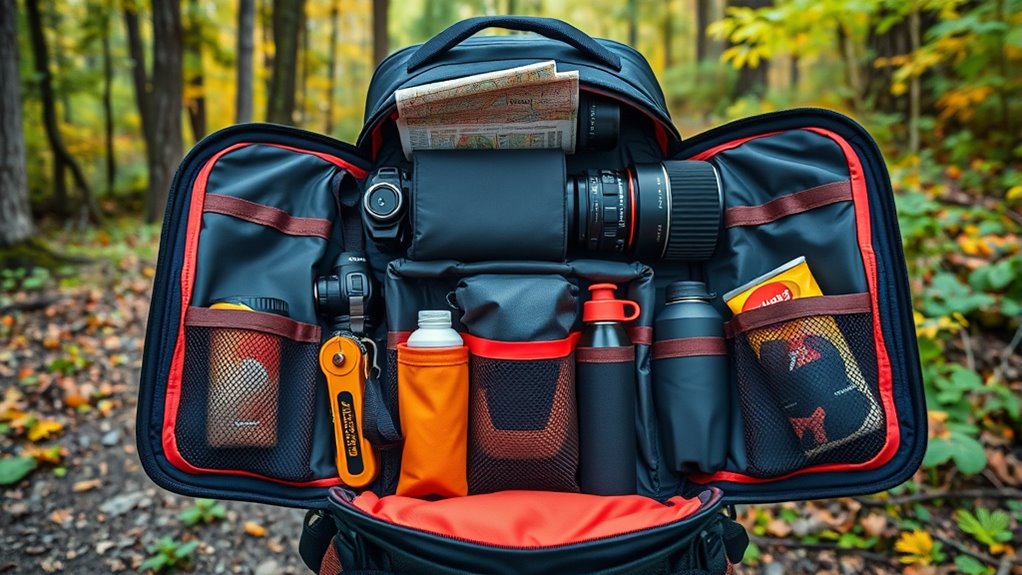
Implementing a zone system transforms your backpack into an organized, easy-to-navigate space by dividing it into specific areas for different items. Use color coding to quickly identify zones—for example, blue for tech gear, red for first aid supplies, and green for snacks. Label tags help you clearly mark each zone, ensuring you immediately know where everything belongs. Assign dedicated sections for essentials like chargers, toiletries, or notebooks, so you avoid rummaging through your bag. This method streamlines packing and access, saving you time and frustration. Keeping similar items grouped together within their zones enhances efficiency, and helps maintain order. Regularly review and adjust your zones as needed, ensuring your system remains practical and tailored to your daily needs. Recognizing the importance of market research can also help you feel more confident about your organization system and your overall readiness for new experiences. Additionally, understanding the types of candy and their characteristics can be helpful if you want to include treats in your pack for special occasions.
Keep Frequently Used Items Accessible
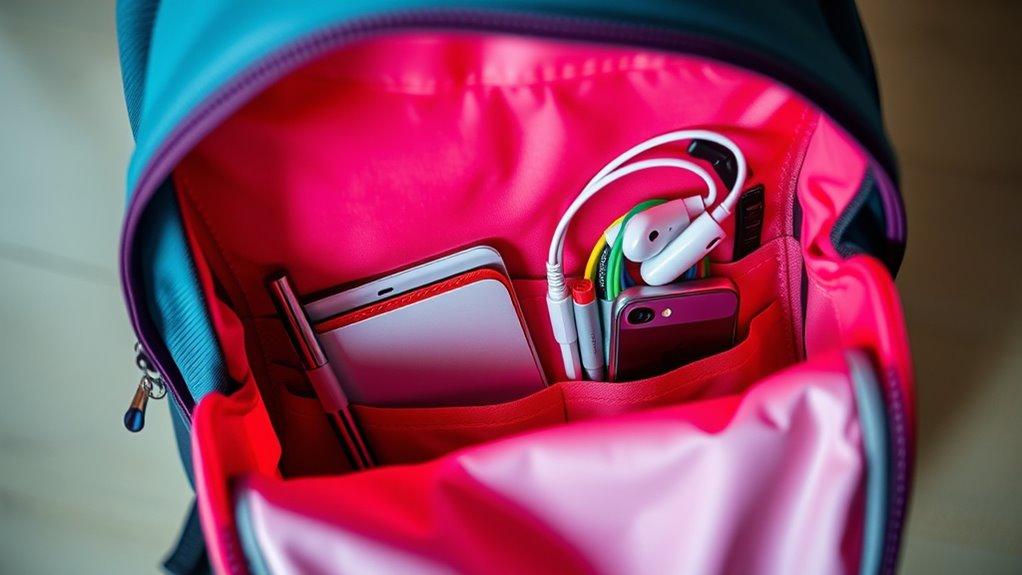
To stay efficient and save time, make sure your most-used items are easily accessible. Using accessibility shortcuts and an ergonomic design helps you quickly grab what you need without digging through your pack. Place essentials like your phone, wallet, or keys in the top or outer pockets for instant access. Prioritize items you frequently use during your day so they’re always within reach. Here are three tips:
Keep your essentials accessible with smart organization and ergonomic placement for quick, hassle-free access.
- Keep daily essentials in a designated outer pocket for quick retrieval.
- Use smaller pouches to organize items for easy access.
- Arrange frequently used gear near the top or in ergonomic zones for effortless reach. Additionally, incorporating wall organization systems can help create visual interest and promote order in your storage spaces, making it easier to locate your gear quickly. Ensuring your backpack setup aligns with accessibility principles can further enhance efficiency and reduce frustration during busy days. For optimal organization, consider adjusting your setup periodically to accommodate changing needs and maximize ergonomic design benefits.
Optimize Your Backpack’s Layout
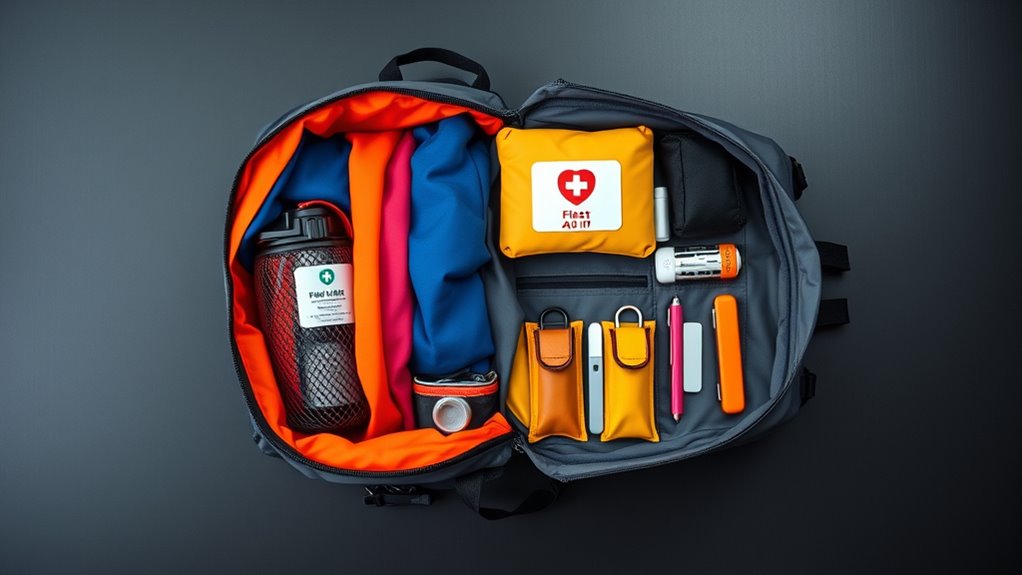
Organizing your backpack’s layout effectively guarantees that everything you need is easy to find and reach. Start by adjusting weight distribution so heavier items are centered and close to your back, reducing strain. This weight balance is essential for comfortable carrying over long periods and can prevent back pain. Proper equipment organization keeps your gear secure and minimizes shifting during movement. This keeps your balance steady and prevents fatigue. Selecting ergonomic straps plays a vital role too; choose ones that fit snugly without digging in, providing comfort during extended wear. Place frequently used items in easily accessible compartments near the top or front of your pack. Heavier gear should go lower to improve stability, while lighter items can be stored toward the top or outer pockets. Properly arranging your gear minimizes shifting and makes packing and unpacking faster. Additionally, understanding machine learning algorithms can help optimize your packing strategy by analyzing what items you use most often and suggesting the best layout. By fine-tuning these elements, your backpack becomes more comfortable and efficient to carry.
Utilize Small Organizers for Small Items
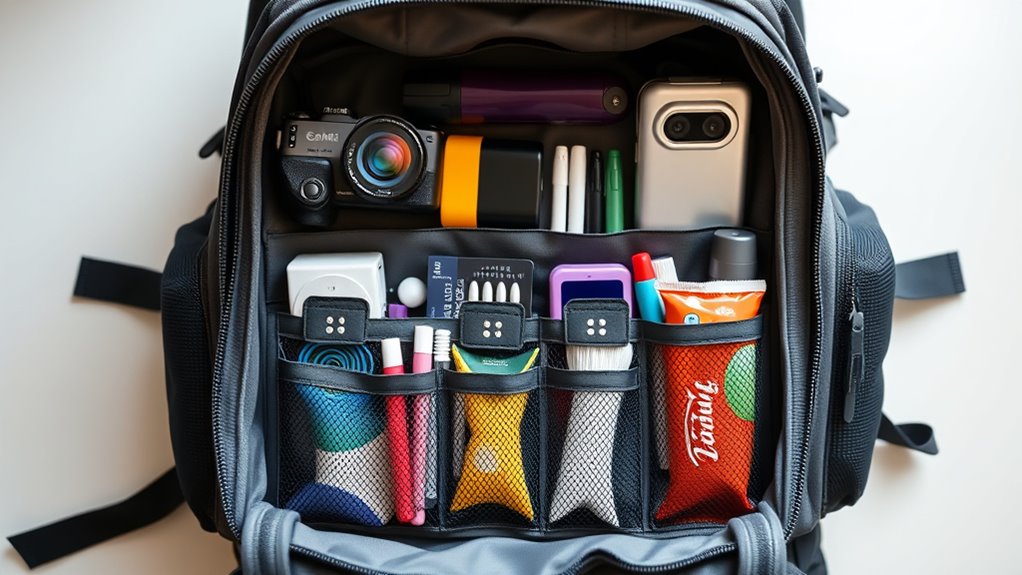
Using small organizers helps you make the most of your backpack’s space. They keep your tiny items sorted by category, so everything stays easy to find. Plus, they protect your items from damage and prevent you from losing important small belongings.
Maximize Space Efficiency
Small items can quickly clutter your backpack if you’re not careful, but small organizers make it easy to keep everything in its place. To maximize space efficiency, focus on compression techniques that reduce bulk and help maintain proper weight distribution. Using small pouches or zippered compartments, you can neatly pack chargers, keys, or snacks, preventing them from shifting and taking up unnecessary space.
Consider these strategies:
- Use compression bags for bulky items like clothing or larger accessories.
- Place heavier items low and close to your back to balance weight.
- Pack small items in designated compartments to avoid wasted space and improve accessibility.
These tips help you utilize every inch of your backpack while keeping it lightweight and organized.
Categorize Small Items
Ever wonder how to keep tiny items from getting lost at the bottom of your backpack? Using small organizers is the key. They help you categorize tech gadgets, travel accessories, and other small essentials, making access quick and easy. Place items like chargers, earbuds, or USB drives in separate compartments or pouches. To visualize, here’s a simple categorization:
| Tech Gadgets | Travel Accessories | Personal Items |
|---|---|---|
| Chargers | Travel-sized Toiletries | Keys |
| Earbuds | Passport Holder | Lip Balm |
| Power Bank | Luggage Tags | Sunglasses |
| Cables | Travel Pillow | Snacks |
This setup saves time, prevents loss, and keeps your backpack neat. Small organizers streamline your packing, ensuring everything you need is always within reach.
Prevent Loss or Damage
To prevent your small items from getting lost or damaged, it’s essential to store them in dedicated organizers within your backpack. Using small pouches or compartments helps keep everything secure and easily accessible. These organizers act as security measures, reducing the risk of theft or accidental loss. For example, you can:
- Use a zipped pouch for valuables like keys and cash, preventing theft.
- Store electronics accessories in a small, padded case to avoid damage.
- Keep medication or important documents in a labeled, secure compartment for quick access and safety.
Maintain Regular Upkeep and Reorganization

Maintaining regular upkeep and reorganization is essential to keep your backpack functional and clutter-free. Establish cleaning routines to remove dirt, crumbs, and clutter regularly, preventing buildup that can make your gear harder to find. As you clean, use shelf labeling to organize compartments and sections, making it easy to identify where everything belongs. Revisit your system weekly or after heavy use to adjust for changing needs or new items. This proactive approach helps prevent forgotten supplies or misplaced items. Keep items in designated spots, and guarantee everything is clean before storing. Consistent upkeep saves time and effort in the long run, allowing you to access your gear quickly and avoid unnecessary stress when you’re in a hurry.
Choose the Right Backpack for Your Needs

Choosing the right backpack starts with understanding your specific needs and how you plan to use it. To guarantee comfort and longevity, look for an ergonomic design that supports your posture and reduces strain. Material durability is also key—opt for sturdy fabrics that withstand daily wear and tear.
Consider these factors:
- Intended Use: Daily commuting, hiking, or travel all require different features.
- Fit and Comfort: Adjustable straps and padded backs enhance comfort.
- Durability and Material: Look for water-resistant fabrics and reinforced seams for longevity.
Tips for Packing Efficiently

Effective packing begins with planning what you’ll need and organizing items strategically to maximize space. Use packing cubes to compartmentalize clothing and gear, making it easier to access items without disrupting your entire pack. Roll clothes instead of folding to save space and reduce wrinkles. Distribute weight evenly by placing heavier items close to your back and at the bottom of your pack, which improves balance and comfort. Keep frequently used items near the top or in external pockets for quick access. Avoid overpacking by only bringing essentials and using compression bags for bulky items. Regularly reassess your packing as you go to prevent unnecessary items from adding weight. Efficient packing guarantees comfort, accessibility, and better weight distribution throughout your adventures.
Frequently Asked Questions
How Do I Prevent Items From Shifting Inside My Backpack?
To prevent items from shifting inside your backpack, focus on proper pocket placement and weight distribution. Place heavier items close to your back and in designated compartments to balance the load. Use smaller pockets for smaller gear to keep everything secure. Tighten straps to stabilize your pack and avoid shifting during movement. Consistently organizing your gear this way guarantees everything stays in place, making your carry more comfortable and efficient.
What Materials Are Best for Durable, Organized Backpack Compartments?
You need gear that’s practically invincible! Waterproof fabrics like nylon or polyester protect against spills and weather, while sturdy mesh dividers keep your items perfectly organized and visible at a glance. These materials withstand the toughest conditions, prevent shifting, and last forever. Choose gear with reinforced seams and durable zippers to guarantee your backpack stays in top shape. With these, your gear stays secure, accessible, and ready for any adventure!
How Can I Customize My Backpack for Different Activities?
You can customize your backpack for different activities by creating activity-specific gear compartments. Use custom compartment ideas like padded sections for electronics, mesh pockets for quick access, and small zippered pouches for essentials. Adjust the layout based on your needs, adding removable dividers or extra pouches. This way, you keep your gear organized and accessible, making it easier to switch between hiking, work, or travel setups seamlessly.
What Techniques Help When Packing for Long Trips?
Imagine opening your packed bag after a long day, knowing everything’s perfectly organized. When packing for long trips, use packing cubes to compartmentalize clothes and essentials. Employ the rolling technique to save space and reduce wrinkles. These methods help you access items quickly and keep your bag tidy, making your journey smoother. With these strategies, you’ll feel confident and prepared, ready to embrace every adventure that awaits.
How Do I Choose the Best Backpack Size for My Needs?
You choose the best backpack size by considering your trip length and gear needs. Opt for a smaller pack with enough space for essentials, but look for one with small pockets to organize smaller items. Make sure strap adjustments fit comfortably, distributing weight evenly. Test the fit by packing it with your gear to ensure it doesn’t feel too bulky or too tight, helping you stay comfortable and organized on your journey.
Conclusion
By thoughtfully organizing your backpack, you ensure quick access and reduce stress on busy days. When you implement a zone system and use small organizers, you mimic the efficiency of a well-oiled machine—proving that order boosts productivity. Remarkably, some studies suggest that organized spaces can actually improve mental clarity. So, take the time to arrange your gear intentionally. A neatly packed backpack isn’t just convenient; it’s a small step toward a more focused, stress-free day.

